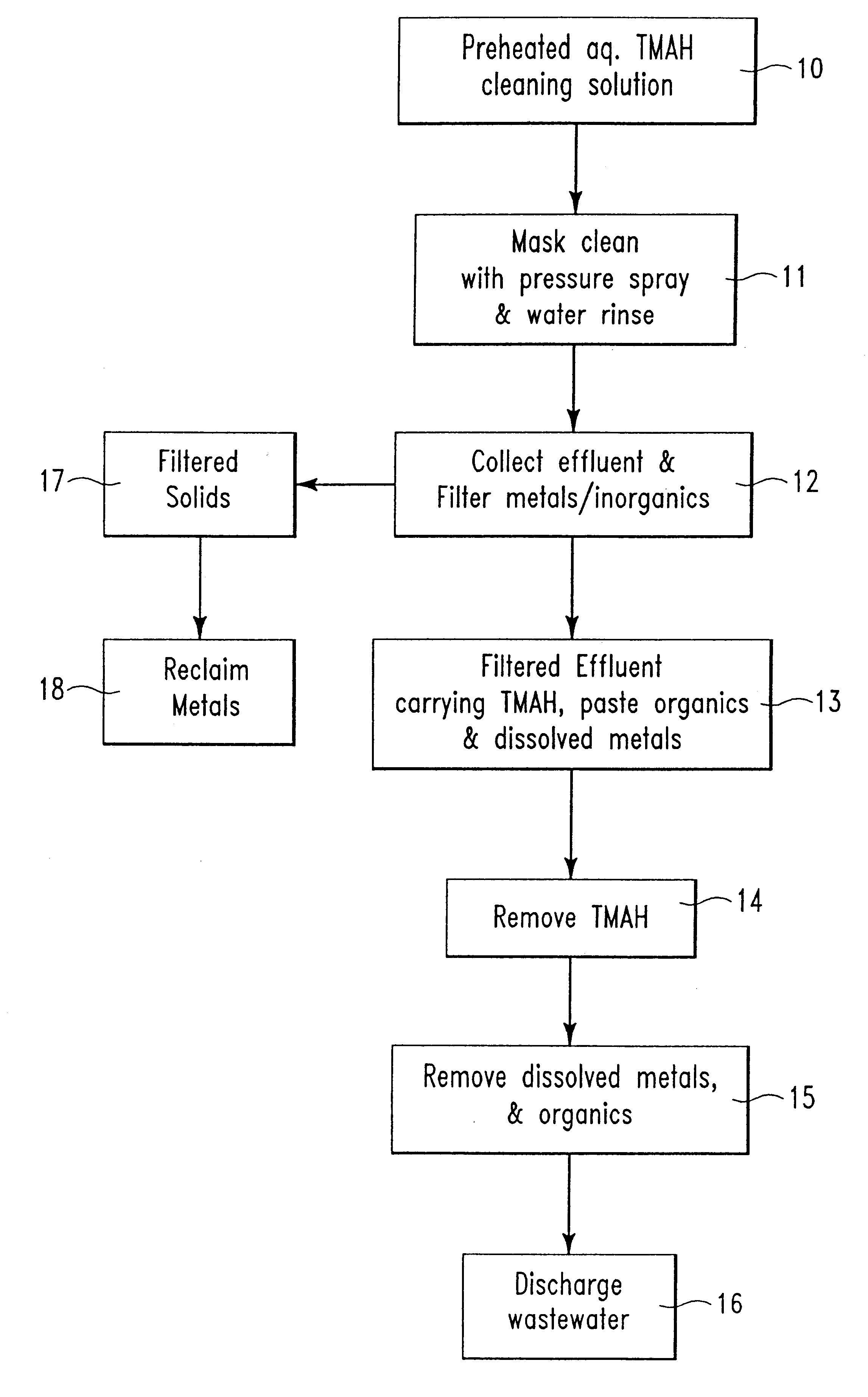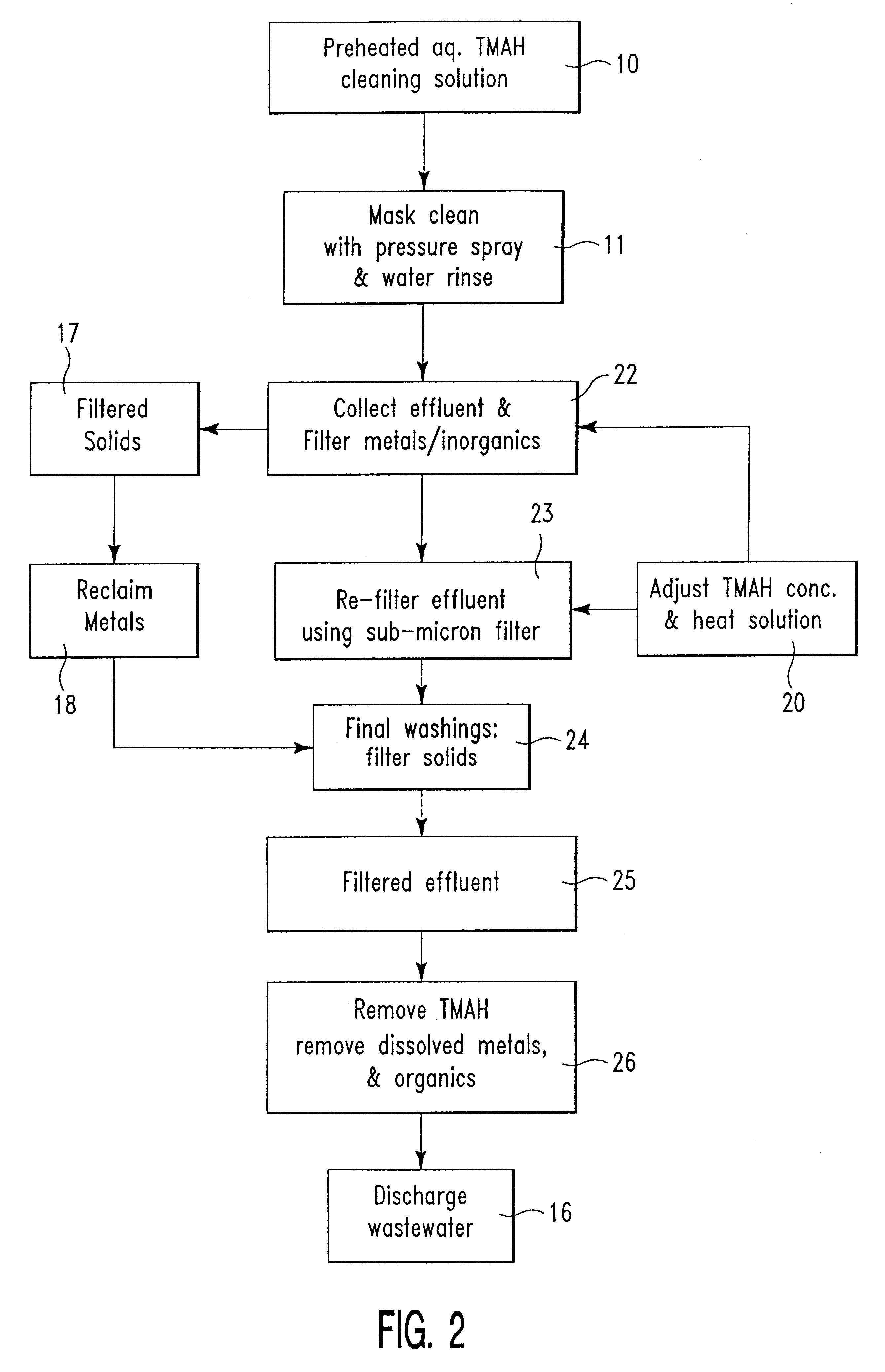Aqueous quaternary ammonium hydroxide as a screening mask cleaner
a technology of ammonium hydroxide and screening mask, which is applied in the direction of cleaning using liquids, inorganic non-surface active detergent compositions, instruments, etc., can solve the problems of paste residue entrapment in the mask, yield loss, solids loading to the waste, etc., and achieves high-efficiency and high-efficiency cleaning of the mask.
- Summary
- Abstract
- Description
- Claims
- Application Information
AI Technical Summary
Benefits of technology
Problems solved by technology
Method used
Image
Examples
example 1
Molybdenum metal masks having fine pitch etched features for via and wiring metallurgical patterns, and for I / O pads, suitable for multi-layer ceramic substrates were used for screening conductive pastes onto ceramic green sheets with a paste screening tool. Various conductive pastes used for screening in ceramic technology generally comprise of a metal powder as the predominant component in a polymer binder-solvent vehicle matrix. Representative pastes screened onto green sheets using the metal masks contained between about 60 to about 85 percent metal powder, typically Molybdenum, Copper, Tungsten, and Nickel, in ethylcellulose type polymer binders, and high boiling polar solvents, for example, 2,2,4-trimethylpentane diol 1,3-monoisobutyrate, or diethylene glycol alkylether acetate in conjunction with fatty acid ester based surfactant, thickening agents, and other additives like antioxidants, coloring agents, corrosion inhibitors, etc.
Also tested were non-polar conductive pastes b...
example 2
Automated high pressure spray cleaning of screening masks with aqueous tetramethyl ammonium hydroxide (TMAH):
About a 0.5 percent solution (wt % based on total solution volume) of TMAH was prepared by diluting one gallon of about 25 wt % aqueous (CH.sub.3).sub.4 N.sup.+ OH.sup.-) concentrate with deionized water to form about 50 gallon of aqueous TMAH cleaning solution. The solution was pre-heated to between about 130.degree. F. to about 150.degree. F. with constant agitation in a heated reservoir with delivery pipes connected to the cleaning tool. Freshly screened Mo metal masks having paste residue from screening of Mo paste were transported to the cleaning chamber a few minutes after the screening pass, and subjected to a high pressure spray wash at about 150 to about 170 psi with the heated TMAH solution, using between about 12 to about 20 second automated wash cycle, followed by a water rinse cycle, and a hot air blow dry. Microscopic inspection of the cleaned masks showed compl...
example 3
Automated high pressure spray cleaning with aqueous tetramethyl ammonium hydroxide (TMAH) with effluent reuse:
About 40 gallons of TMAH cleaning solution comprising about 0.5 wt. % of TMAH, was prepared by diluting about one gallon of about 25 wt % aqueous TMAH concentrate with about 49 gallons of deionized water. The solution was pre-heated to between about 160 to about 170.degree. F. with constant agitation, in a reservoir with delivery pipes connected to the cleaning tool. Masks carrying screening paste residue were spray cleaned, water rinsed and dried according to the conditions described in Example 1. The wash and rinse from each mask was combined and filtered first through a 5-10 micron coarse filter to remove separated metal and inorganic solids, followed by microfiltration using about 0.2 micron cartridge filter. The filtered effluent was reconstituted to the original concentration of about 0.5 wt % TMAH by adding additional volume of the 25 wt % TMAH concentrate to make up ...
PUM
| Property | Measurement | Unit |
|---|---|---|
| temperature | aaaaa | aaaaa |
| pressure | aaaaa | aaaaa |
| pressure | aaaaa | aaaaa |
Abstract
Description
Claims
Application Information
 Login to View More
Login to View More - R&D
- Intellectual Property
- Life Sciences
- Materials
- Tech Scout
- Unparalleled Data Quality
- Higher Quality Content
- 60% Fewer Hallucinations
Browse by: Latest US Patents, China's latest patents, Technical Efficacy Thesaurus, Application Domain, Technology Topic, Popular Technical Reports.
© 2025 PatSnap. All rights reserved.Legal|Privacy policy|Modern Slavery Act Transparency Statement|Sitemap|About US| Contact US: help@patsnap.com



